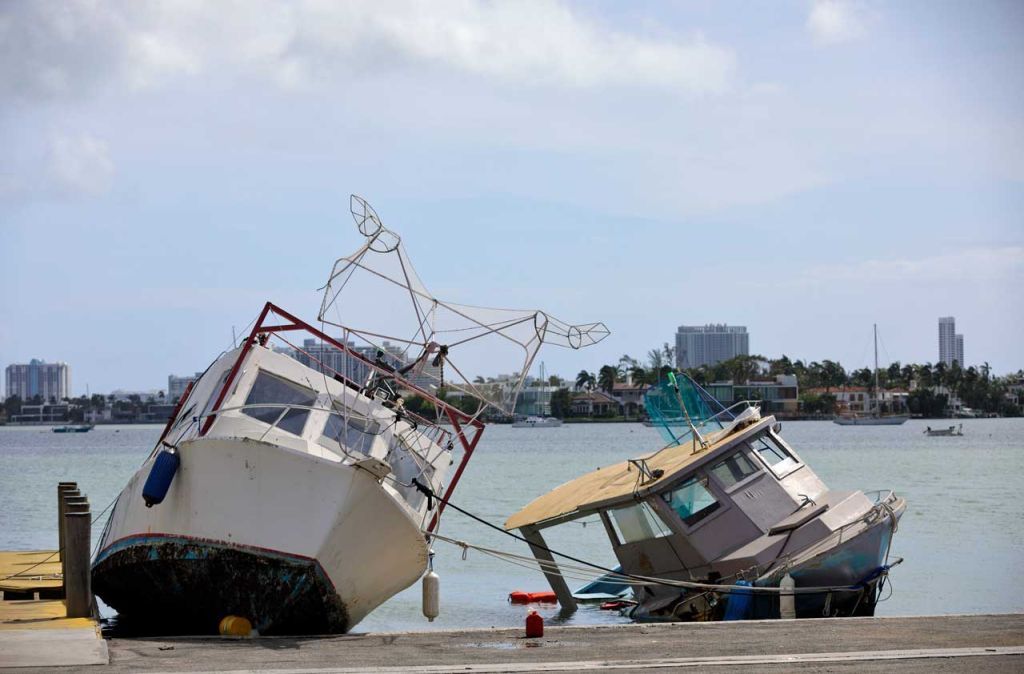The Most Expensive Natural Disasters in U.S. History
Hurricane Ian could join this list of wind, water, fire and drought events that have all wreaked havoc on the United States. What’s been the worst?
- (opens in new tab)
- (opens in new tab)
- (opens in new tab)
- Newsletter sign up Newsletter


Hurricane Ian was one of the most powerful storms to hit the United States, with massive storm surges lashing Florida’s southwest coast, along with high winds and flooding across the state.
That storm surge (damage from which, by the way, is not covered by homeowner’s insurance) is the main source of hurricanes' damage: The top eight in our list of 10 most expensive natural disasters are all cyclonic storms. Whether Ian joins this grim list remains to be seen, but based on early cost estimates from the Insurance Information Institute and other sources, it’s probable.
Neither hurricane nor wildfire season are over yet, so check your emergency kit, have a financial plan in place in case you have to evacuate, and take a look at the 10 most expensive natural disasters in U.S. history.
Estimated cost and death figures are from the NOAA’s National Centers for Environmental Information. Estimated costs are adjusted for inflation.
U.S. Billion-Dollar Weather and Climate Disasters (2022). https://www.ncei.noaa.gov/access/billions/, DOI: 10.25921/stkw-7w73

10. Hurricane Ike (2008), $40.2 Billion in Damage
Deaths: 112
Hurricane Ike was only a Category 2 hurricane when it struck land in September 2008, but its size was exceptional.
Tropical-force winds extended a total of 425 miles from the northwest to the southeast as the eye came across Texas, bringing a destructive and deadly storm surge across the Texas and southwest Louisiana coasts.
That area is home to extensive oil and gas drilling, along with associated industries, and the storm resulted in severe gasoline shortages in the southeast U.S. due to damaged oil platforms, storage tanks, pipelines and refineries. Fuel prices across the country — and into Canada — spiked.
Many waterfront communities, including Galveston, Texas, and the nearby Bolivar Peninsula, were hit hard. Even the Houston Texans’ NFL home opener had to be delayed due to damage to Reliant Stadium.

9. Great Flood of 1993, $38.6 Billion in Damage
- Deaths: 48
Storms get official names from the U.S. government; floods don’t. But the persistent heavy rains and thunderstorms that swelled the Mississippi and Missouri rivers and their tributaries became known as the Great Flood of 1993. The National Weather Service considers it the "largest and most significant flood event ever to occur in the United States."
A huge swath of the Midwest was affected, and much of the river economy was shut down. Barge traffic was stopped for two months. Major bridges across the Missouri and Mississippi were out or inaccessible. Even commercial airports were flooded. And millions of acres of farmland were underwater.

8. Drought and Heat Wave (1988), $50.6 Billion in Damage
- Deaths: 454
1988’s drought struck a large portion of the U.S., with severe losses to agriculture and related industries; the upper Midwest was particularly hard hit. Eleven states officially declared all of their counties disaster areas.
The combined flow of the three largest rivers in the lower 48 states — the Mississippi, St. Lawrence and Columbia — was 45% below normal in June, marking the lowest combined June flow in 60 years, according to a report by NOAA. Combined direct and indirect deaths due to heat stress were estimated at 5,000. Regional impacts of the drought lasted into 1999.

7. Hurricane Andrew (1992), $51.3 Billion in Damage
- Deaths: 61
Hurricane Andrew was a compact but incredibly powerful cyclone — one of only four storms to hit the U.S. as a Category 5, with winds of 157 mph or higher. And it was those winds, rather than the storm surge, that did most of the damage to South Florida in August 1992, peeling the paint off buildings, pulling trees and utility poles from the ground, and flipping cars and semi-trailers. Among the locations damaged: NOAA’s own meteorological lab, on Key Biscayne, just outside Miami. Andrew gave the region little time to prepare. The first storm of the season, it weakened so significantly as it headed west across the Atlantic that the National Hurricane Center almost stopped tracking it. But then it set a course for land and blew up to its peak strength in less than 36 hours.
Memorable images from this storm include the almost-complete devastation of the town of Homestead, Fla. The nearby Homestead Air Force Base, pictured above, also suffered heavy damage (it today functions as an Air Force Reserve location. The storm came ashore a second time, as a Category 3 storm, in Louisiana as well.
Andrew also led to far more stringent building codes in Florida; many homes are now required to have storm shutters or impact-resistant glass.

6: Hurricane Irma (2017), $59.5 Billion in Damage
- Deaths: 97
Irma first directed its wrath on two of the U.S. Virgin Islands, St. John and St. Thomas, devastating both while still a Category 5 storm. It had only weakened to Category 4 when it made landfall at Cudjoe Key, Fla., in September 2017. The Florida Keys were heavily impacted, according to NOAA, with 25% of buildings destroyed and 65% significantly damaged. Wind and storm-surge damage occurred along the coasts of Florida and South Carolina, with Jacksonville experiencing the worst flooding in more than 200 years. Irma maintained a maximum sustained wind of 185 mph for 37 hours, the longest in the era of satellite observation.

5. Hurricane Ida (2021), $59.5 Billion in Damage
- Deaths: 96
Oh look, another hurricane whose name starts with “I.” Not a coincidence, at least according to The Washington Post. Given the use of an alphabetical naming convention for hurricanes (a tradition that dates back to the 1950s, it’s simply a matter of timing that the “typical peak of the hurricane season between mid-August and the end of September,” which generates the most destructive storms, coincides with the middle of the alphabet.
According to NOAA, when Hurricane Ida struck near Port Fourchon, Louisiana, it was one of three hurricanes in recorded history to make landfall in Louisiana with 150 mph winds. “Heavy damage to the energy infrastructure across southern Louisiana causing widespread, long duration power outages to millions of people,” NOAA reported. “Parts of New Orleans were without power for nearly a week due to the widespread damage.”
And Ida didn’t just give Louisiana a bit of a flashback to Katrina’s impact – it managed to also remind the Northeast about Superstorm Sandy (next up in our rogue’s gallery). Ida joined up with a frontal system to drop inches of rain across a wide region from eastern Pennsylvania to New York. Flash flood emergencies were declared in New Jersey and New York for the first time, producing damage to homes, businesses, vehicles and infrastructure while also causing dozens of fatalities.

4. Superstorm Sandy (2012), $82.0 Billion in Damage
- Deaths: 159
Sandy was no longer a hurricane when it came ashore at Atlantic City, N.J., in October 2012. But the storm was still giant (in diameter), even if winds were off the mark. Furthermore, the landing of what became known as Superstorm Sandy happened at high tide, exacerbating the storm surge that brought waves inland and flooded large swaths of the northeast coast. Lower Manhattan was particularly hard hit, with the Brooklyn-Battery Tunnel completely flooded. The New York Stock Exchange had to close for two days in a row, the first time that had happened since a snowstorm in 1888. Effects of the saltwater inundation linger to this day on the train tunnel that runs under the Hudson River, a critical link in the northeast’s transportation infrastructure.
New York and New Jersey bore the brunt, but all the coastal northeast states suffered extensive damage. Further inland, the storm merged with a developing nor’easter to pummel parts of the Appalachian ridge with wind, rain and heavy snow.

3. Hurricane Maria (2017), $107.1 Billion in Damage
- Deaths: 2,981
The last of 2017’s troika of Category 4 storms to hit the U.S., Maria will be most remembered for the damage it did to Puerto Rico (though it also struck St. Croix, the U.S. Virgin Island that had just been spared by Hurricane Irma). One of the deadliest storms to impact the U.S., with numerous indirect deaths in the wake of the storm’s devastation, Maria left the island’s transportation, agriculture, communication and energy infrastructure devastated. Virtually everyone was left without power, and cellular communications were down as well, complicating rescue efforts. Extreme rainfall of up to 37 inches caused widespread flooding and mudslides across the island, and rebuilding is expected to take years.

2. Hurricane Harvey (2017), $148.9 Billion in Damage
- Deaths: 89
Hurricanes cause damage due to a combination of wind, storm surge and rain, but the proportions vary. In Hurricane Harvey’s case, it was the extreme rainfall; once the storm lurched ashore near Rockport, Texas, (as a Category 4) in August 2017, it stalled over one of the most densely populated areas of the Gulf Coast.
Per NOAA, the storm was the most significant tropical cyclone rainfall event in U.S. history — both in scope and peak rainfall amounts — since reliable rainfall records began around the 1880s. A frog-strangling 60 inches fell on Nederland, Texas, but high water levels were widespread, with more than 30 inches of rain falling on 6.9 million people. The result was massive flooding that displaced more than 30,000 people and damaged or destroyed more than 200,000 homes and businesses.

1. Hurricane Katrina (2005), $186.3 Billion in Damage
- Deaths: 1,833
Hurricane Katrina will long be remembered for its cost in lives and dollars, as well as the harder-to-measure human suffering it brought to the Louisiana, Mississippi and Alabama coasts — in particular, New Orleans.
Striking the northern Gulf Coast as a Category 3 storm, Katrina weakened quickly, but not before bringing with it a storm surge that in some places exceeded 20 feet, overtopping many levees and seawalls meant to protect the low-lying area. About 80% of the city of New Orleans flooded, to varying depths, within a day or so after landfall of the eye. With so many houses destroyed, many who fled never came back; the city’s population is still below its pre-storm levels.
Along the coast, the storm surge was exacerbated by heavy waves, a leftover from when Katrina had reached Category 5 strength while over the Gulf. Coastal structures — including many oil rigs — were battered.

In his current role as Senior Online Editor, David edits and writes a wide range of content for Kiplinger.com. With more than 20 years of experience with Kiplinger, he has worked on and written for a range of its publications, including The Kiplinger Letter and Kiplinger’s Personal Finance magazine. He is a co-host of Your Money's Worth, Kiplinger's podcast and has helped develop the Economic Forecasts feature.
-
-
 IRS Service Improvements Could Bring Faster Tax Refunds
IRS Service Improvements Could Bring Faster Tax RefundsRecent IRS improvements mean taxpayers could see faster tax refunds next year and beyond.
By Katelyn Washington • Published
-
 For Best Tax Savings, Year-Round Tax Planning Is Essential
For Best Tax Savings, Year-Round Tax Planning Is EssentialFor optimal, ongoing tax reduction, consider employing these nine strategies throughout the entire year.
By Andy Leung, Private Wealth Adviser • Published
-
 5 Great Places to Buy a Vacation Home
5 Great Places to Buy a Vacation HomeWith remote work on the rise, more people are looking for a permanent getaway.
By Ellen Kennedy • Published
-
 The 10 Cheapest Countries to Visit
The 10 Cheapest Countries to VisitDespite inflation, there are some areas where the strong dollar will definitely work in your favor. Travel, for example... we find the cheapest places to visit around the world.
By Quincy Williamson • Published
-
 The 25 Cheapest Places to Live: U.S. Cities Edition
The 25 Cheapest Places to Live: U.S. Cities Editionplaces to live Have a look at the cheapest places to live in America for city dwellers. Is one of the cheapest places to live in the U.S. right for you?
By Dan Burrows • Last updated
-
 Should I Cancel Amazon Prime? Here Are 12 Good Reasons
Should I Cancel Amazon Prime? Here Are 12 Good ReasonsAmazon Prime The giant retailer had a year of ups and downs, leaving many wondering: Do I need Amazon Prime?
By Bob Niedt • Published
-
 Kiplinger's Retail Outlook: Consumers Are Still Resilient
Kiplinger's Retail Outlook: Consumers Are Still ResilientEconomic Forecasts Kiplinger's Retail Outlook: Sales this year are likely to be mostly stable, even as the economy slows.
By David Payne • Last updated
-
 Kiplinger Jobs Outlook: More Slowdown, But Gradual
Kiplinger Jobs Outlook: More Slowdown, But GradualEconomic Forecasts The March jobs report signals an economic slowdown is in progress, but it may not be fast.
By David Payne • Last updated
-
 Kiplinger’s Interest Rates Outlook: Rates Likely to Rise Again After Banking Crisis is Over
Kiplinger’s Interest Rates Outlook: Rates Likely to Rise Again After Banking Crisis is OverEconomic Forecasts Kiplinger’s Interest Rates Outlook: Rates Likely to Rise Again After Banking Crisis is Over
By David Payne • Last updated
-
 Kiplinger Housing Outlook: Existing-Home Sales Show Signs of Life in February
Kiplinger Housing Outlook: Existing-Home Sales Show Signs of Life in FebruaryEconomic Forecasts Kiplinger Housing Outlook: Existing-Home Sales Show Signs of Life in February
By Rodrigo Sermeño • Last updated










